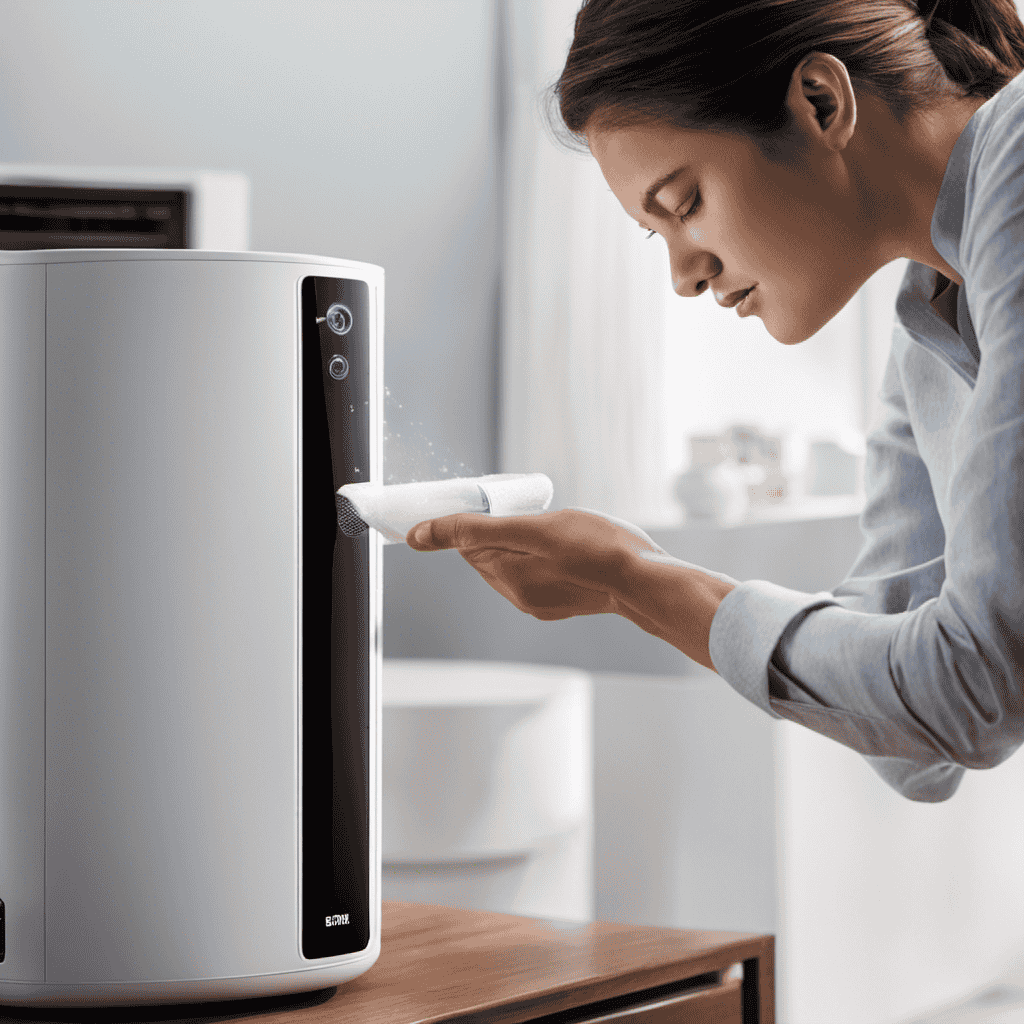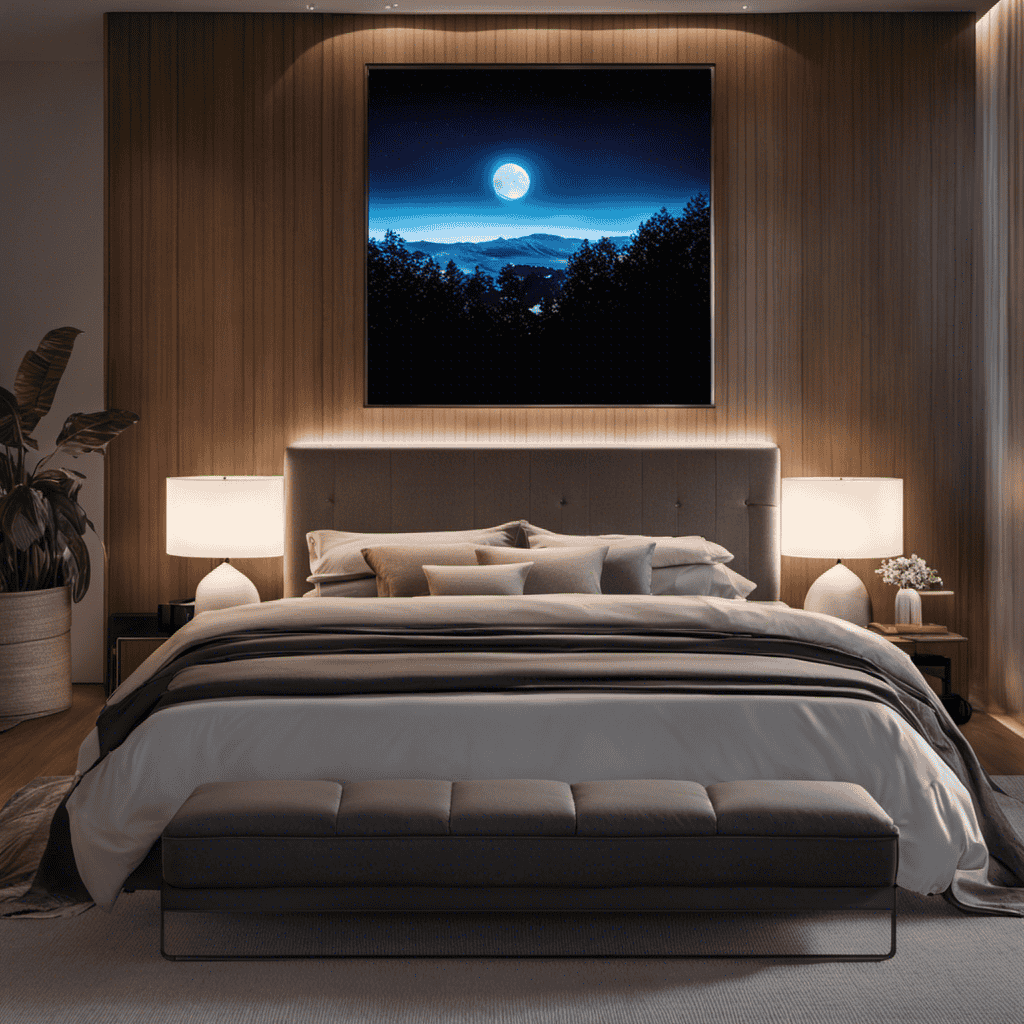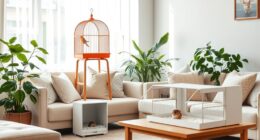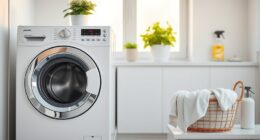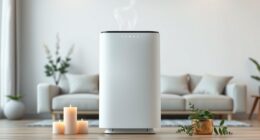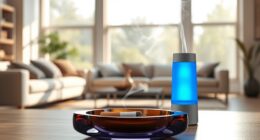Hello there!
So, let’s talk about a little secret of mine – how to hide an air purifier.
We all know the importance of clean air, but sometimes those devices can be a bit of an eyesore, right?
Well, fear not! I’ve got some clever tricks up my sleeve that will help you seamlessly integrate your air purifier into your home decor.
From furniture integration to stylish covers, I’ve got you covered.
So, let’s dive in and discover the art of camouflaging that air purifier!
Key Takeaways
- Use decorative plant covers or furniture slipcovers to hide the air purifier and blend it with your existing decor.
- Explore DIY disguises or stylish covers that match your room’s color scheme and style.
- Place the air purifier behind furniture or large plants to camouflage it and keep it hidden in plain sight.
- Consider furniture integration techniques such as using multi-functional furniture with hidden compartments or ventilation options for discreet air purifier placement.
Creative Camouflage Ideas
You can try using decorative plant covers or furniture slipcovers to hide your air purifier. Camouflaging techniques can help seamlessly blend your air purifier into your home decor.
One DIY disguise idea is to place a decorative plant cover over your air purifier to make it look like a potted plant. Choose a cover that matches the style and color scheme of your room.
Another option is to use a furniture slipcover to hide the air purifier. This works particularly well if your air purifier is placed on a side table or shelf. Opt for a slipcover that matches your existing furniture, such as a chair or sofa cover.
With these simple camouflaging techniques, you can effectively conceal your air purifier while adding a touch of style to your space.
Furniture Integration Techniques
When it comes to integrating furniture into your living space, there are a few key techniques that can help you achieve a seamless and functional design.
First, camouflaging your furniture with existing decor can create a cohesive and visually pleasing look.
Additionally, opting for multi-functional furniture options allows you to make the most of your space by serving multiple purposes.
Lastly, creative storage solutions can help you keep your belongings organized and out of sight, while still adding a stylish touch to your home.
Camouflaging With Existing Decor
To better blend your air purifier with your existing decor, consider using fashionable disguises or placing it behind furniture.
Decorative covers are a great way to transform the appearance of your air purifier and make it blend seamlessly with your interior design. You can find a wide range of covers in different patterns, colors, and materials to match your style and taste. These covers not only hide the purifier but also add an aesthetic touch to your space.
Another option is to place the purifier behind furniture, such as a bookshelf or a large plant, to keep it hidden in plain sight. This allows you to maintain clean air without compromising the overall look of your room.
Now, let’s explore some multi-functional furniture options that can further assist in disguising your air purifier.
Multi-Functional Furniture Options
Consider using furniture that serves multiple purposes, such as a storage ottoman or a side table with built-in shelves, to cleverly conceal your air purifier. These multi-purpose designs not only provide practical storage solutions but also help maintain the aesthetic appeal of your living space. With hidden ventilation options, you can ensure proper air circulation without compromising on style.
To give you an idea of the options available, here is a table showcasing some versatile furniture pieces that can effectively hide your air purifier:
| Furniture Piece | Features |
|---|---|
| Storage Ottoman | Concealed compartment for air purifier |
| Side Table with Shelves | Built-in shelves for discreet placement |
| Bookcase with Cabinet | Hidden cabinet for air purifier |
| TV Stand with Storage | Integrated storage space for air purifier |
| Coffee Table with Drawers | Concealed drawers for air purifier |
Creative Storage Solutions
By utilizing these versatile furniture pieces, you can cleverly conceal your air purifier while still maintaining a stylish and clutter-free living space. Here are some creative storage solutions that will help you hide your air purifier effectively:
-
Storage Ottoman: Choose an ottoman that doubles as a storage unit. You can place your air purifier inside and use the ottoman as a footrest or extra seating.
-
Bookcase with Cabinet: Opt for a bookcase that has a closed cabinet at the bottom. This allows you to store your air purifier discreetly while displaying your favorite books or decorative items on the shelves.
-
Console Table with Hidden Compartment: Look for a console table with a hidden compartment where you can tuck away your air purifier. This functional piece of furniture adds style and functionality to any room.
-
TV Stand with Concealed Storage: Invest in a TV stand that has hidden compartments or sliding panels. This way, you can keep your air purifier hidden while enjoying your favorite shows.
-
Floating Shelf with Secret Compartment: Install a floating shelf with a hidden compartment to hide your air purifier. This space-saving technique not only conceals your purifier but also adds a modern touch to your decor.
With these hidden air purifier storage ideas, you can enjoy clean air without sacrificing style or space in your home.
Wall-Mounted Air Purifier Solutions
Wall-mounted air purifiers are a great solution for saving space in smaller rooms. When installing a wall-mounted air purifier, there are a few key tips to keep in mind.
First, choose a location that is centrally located in the room for optimal air circulation. Mount the purifier at eye level to ensure it effectively captures pollutants in the air.
Additionally, consider mounting the unit away from doors and windows to prevent outside air from interfering with its efficiency. Regularly cleaning or replacing the filters will maximize the air purifier’s efficiency in removing allergens, dust, and other pollutants from the air.
With proper installation and maintenance, a wall-mounted air purifier can provide clean and fresh air while saving valuable floor space.
DIY Air Purifier Enclosures
To create your own DIY enclosure for your purifier, start by selecting a sturdy and breathable material. You want to ensure that the material allows for proper airflow while also providing a barrier for any dust or debris that may be present in the room. Here are some options to consider:
-
Fabric: Choose a fabric that is thick and tightly woven, such as canvas or upholstery fabric. This will help to keep the air purifier hidden while still allowing for efficient air circulation.
-
Wood: Build a wooden box or cabinet that can house the air purifier. Make sure to leave ample space for the air intake and outlet vents.
-
Room divider: Utilize a room divider or screen to create a designated area for the air purifier. This can help to camouflage the device while also adding a decorative element to your space.
-
Bookshelf: Incorporate the air purifier into a bookshelf by creating a designated shelf or compartment for it. This will help to blend the device in with your existing decor.
-
Plant stand: Place the air purifier on a tall plant stand to elevate it and make it less noticeable. You can also add some potted plants around it to further disguise the device.
Smart Home Integration Tips
When it comes to smart home integration, there are several key points to consider.
First and foremost, the benefits of integration are numerous, including increased convenience, energy efficiency, and enhanced security.
Secondly, it is important to ensure that the smart devices you choose are compatible with your existing home automation system, as this will make the setup process much smoother.
Lastly, if you encounter any issues or need assistance with setup or troubleshooting, there are resources available such as online forums, customer support, and user manuals that can help guide you through the process.
Benefits of Integration
You’ll love the benefits of integrating your air purifier seamlessly into your home decor. Not only does it provide clean air, but it also enhances the overall aesthetic of your space.
Here are some reasons why integrating your air purifier is a great idea:
-
Improved air quality: By integrating your air purifier into your home decor, you can ensure that you and your family are breathing in clean and fresh air.
-
Health benefits: Clean air is essential for maintaining good health. By removing harmful pollutants and allergens from the air, an integrated air purifier can help reduce respiratory issues and allergies.
-
Energy efficiency: Many modern air purifiers are designed to be energy-efficient, saving you money on your electricity bills.
-
Noise reduction: Integrated air purifiers are often designed to operate quietly, minimizing any distracting noise in your home.
-
Space-saving: Integrating your air purifier into your home decor allows you to free up valuable floor space, making your home more spacious and organized.
Compatible Smart Devices
Smart devices that are compatible with your integrated air purifier can offer convenient control and monitoring options. Having a smart device that can connect to your air purifier opens up a world of possibilities for managing your indoor air quality.
With smart device compatibility, you can easily control your air purifier using voice commands or through an app on your phone. This means you can adjust settings, turn the purifier on or off, and even schedule cleaning cycles without having to physically interact with the device.
Additionally, some smart devices offer real-time monitoring of air quality levels, allowing you to stay informed and make adjustments as necessary. Voice control options make using your air purifier effortless and hands-free, providing a seamless integration into your smart home ecosystem.
Setup and Troubleshooting
Setting up and troubleshooting your integrated air purifier can be made easier with the help of the instruction manual. It is important to properly maintain your air purifier to ensure its optimal performance.
Here are some helpful maintenance and troubleshooting techniques:
- Clean the filters regularly to remove dust and debris.
- Check for any loose connections or damaged cords.
- Ensure proper ventilation around the air purifier.
- Monitor the air quality indicators and adjust settings accordingly.
- If you encounter any issues, refer to the troubleshooting section of the manual or contact customer support for assistance.
Regular maintenance and effective troubleshooting techniques will help keep your air purifier running smoothly and ensure that you and your family breathe clean and fresh air.
Stylish Air Purifier Covers
To make your air purifier blend seamlessly with your decor, try using stylish covers that add a touch of elegance to any room. These decorative air purifier covers not only serve as a design element, but also help to hide the purifier and create a more cohesive look in your space. There are a variety of options available, from sleek and modern designs to more traditional and ornate styles. To give you an idea of what’s out there, here’s a table showcasing a few stylish air purifier stands and covers:
| Stand/Cover | Description |
|---|---|
| Wooden Stand | Natural wood finish with clean lines |
| Geometric Cover | Modern geometric pattern in vibrant colors |
| Woven Rattan Stand | Bohemian-inspired rattan weave |
| Embroidered Cover | Delicate embroidery on a fabric cover |
With these stylish options, you can easily incorporate your air purifier into your home decor while keeping it out of sight. Now let’s move on to explore some clever storage solutions.
Transition: Now that we’ve discussed how to make your air purifier stylish, let’s explore some clever storage solutions to keep your space organized and clutter-free.
Clever Storage Solutions
Now that we’ve covered how to incorporate your air purifier into your decor, let’s take a look at some clever storage solutions to keep your space organized and clutter-free.
Here are five clever organization hacks and space-saving techniques that will help you hide your air purifier while maximizing storage:
-
Hidden Cabinets: Install custom-built cabinets with a hidden compartment specifically designed to house your air purifier. This way, you can easily access it when needed, but keep it out of sight when not in use.
-
Multipurpose Furniture: Invest in furniture pieces that serve a dual purpose, such as ottomans or side tables with hidden compartments. These can discreetly store your air purifier while providing additional seating or storage space.
-
Floating Shelves: Install floating shelves high on the wall to create a stylish display area for books, plants, or decorative items. You can place your air purifier on one of these shelves, blending it seamlessly with the rest of your decor.
-
Built-in Storage: Consider incorporating built-in storage units, such as bookcases or wall units, that can accommodate your air purifier. These units can be customized to match your existing decor and provide ample storage space for other belongings.
-
Camouflage with Plants: Use tall, leafy plants strategically placed around your air purifier to camouflage it. Not only will this hide the purifier, but it will also enhance the overall aesthetic of your space.
Frequently Asked Questions
How Do I Know if an Air Purifier Is Effective in Hiding the Device?
To determine if an air purifier effectively hides the device, evaluate its features and compare it to other models. Look for features like noise level, size, and design that can help it blend seamlessly into your space.
Can I Use Plants to Camouflage My Air Purifier?
Using plants as a creative alternative to hide an air purifier is a DIY solution that can add aesthetic appeal to any room. By strategically placing foliage around the device, it can blend seamlessly into your decor while still maintaining its effectiveness.
Are There Any Specific Furniture Pieces That Work Best for Integrating an Air Purifier?
Furniture options can be great for integrating an air purifier into your home. From bookcases with concealed compartments to side tables with hidden shelves, there are creative hiding spots that can seamlessly blend your air purifier into your decor.
Are There Any Safety Concerns When Wall-Mounting an Air Purifier?
When wall-mounting an air purifier, it’s important to consider potential risks. Ensure the installation is secure and follow the manufacturer’s guidelines. Protect against electrical hazards and make sure the unit is properly ventilated.
What Are Some Popular Smart Home Devices That Can Be Integrated With an Air Purifier?
There are many popular smart home devices that can be integrated with an air purifier. This integration offers several benefits such as remote control, automation, and real-time air quality monitoring.
What are the Best Ways to Conceal an Air Purifier in a Room?
When it comes to concealing an air purifier in a room, there are a few clever tricks to keep it out of sight. Consider placing it behind furniture, using a decorative screen, or incorporating it into a bookshelf. By utilizing these methods, you can effectively hide the air purifier without impacting the air purifier cost analysis.
Conclusion
In conclusion, hiding your air purifier can be a fun and creative endeavor. From integrating it into your furniture to mounting it on the wall, there are plenty of options to suit your style and space.
DIY enclosures and stylish covers can also add a touch of elegance to your home while keeping your air purifier discreet. And don’t forget about smart home integration and clever storage solutions!
With these tips and tricks, you can make your air purifier blend seamlessly into your living space, like a chameleon in its environment, purifying the air without compromising on style.

